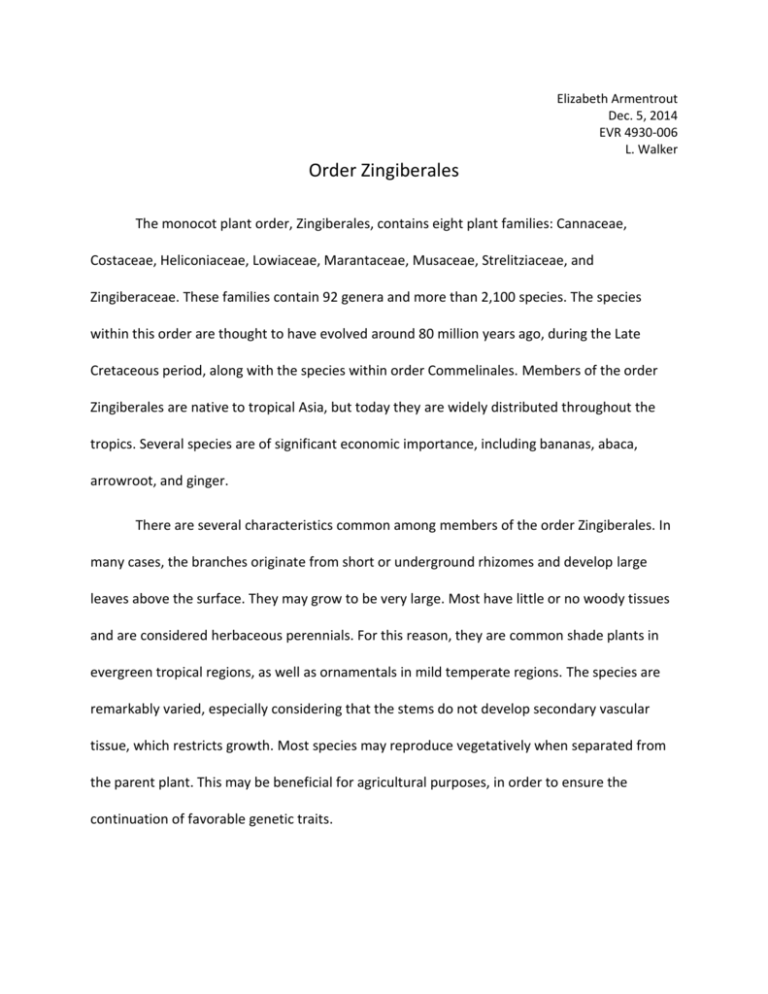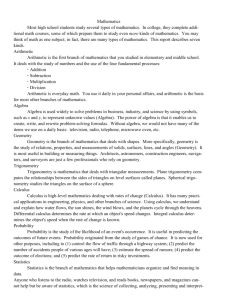File - Elizabeth J. Armentrout
advertisement

Elizabeth Armentrout Dec. 5, 2014 EVR 4930-006 L. Walker Order Zingiberales The monocot plant order, Zingiberales, contains eight plant families: Cannaceae, Costaceae, Heliconiaceae, Lowiaceae, Marantaceae, Musaceae, Strelitziaceae, and Zingiberaceae. These families contain 92 genera and more than 2,100 species. The species within this order are thought to have evolved around 80 million years ago, during the Late Cretaceous period, along with the species within order Commelinales. Members of the order Zingiberales are native to tropical Asia, but today they are widely distributed throughout the tropics. Several species are of significant economic importance, including bananas, abaca, arrowroot, and ginger. There are several characteristics common among members of the order Zingiberales. In many cases, the branches originate from short or underground rhizomes and develop large leaves above the surface. They may grow to be very large. Most have little or no woody tissues and are considered herbaceous perennials. For this reason, they are common shade plants in evergreen tropical regions, as well as ornamentals in mild temperate regions. The species are remarkably varied, especially considering that the stems do not develop secondary vascular tissue, which restricts growth. Most species may reproduce vegetatively when separated from the parent plant. This may be beneficial for agricultural purposes, in order to ensure the continuation of favorable genetic traits. The plants in the order Zingiberales typically have flowers with three distinct sepals, three petals, and three carpels. They may have up to six stamens in whorls of three, some of which may be sterile structures. The ovary is enclosed and inferior. The calyx differs in size and shape from the corolla. The flowers are zygomorphic in most cases, but some are asymmetric. They may exhibit one functional stamen accompanied by two staminodes forming the conspicuous part of the flower. There are three monophyletic families within Zingiberales – Cannaceae, Heliconiaceae, and Lowiaceae. Additionally, the families Costaceae, Heliconiaceae, and Lowiaceae are generally valued primarily for horticultural purposes. The family Cannaceae contains one genus, Canna, and 19 species. It is known for the species Canna edulis and Canna indica which, along with other species of the genus, contain edible, starchy, tuberous rhizomes. Many species are notable for large, showy flowers. The family Heliconiaceae contains one genus, Heliconia, but 198 species. Most species are indigenous to the tropical Americas and the western Pacific. The family Lowiaceae contains one genus, Orchidantha, which accepts 17 species. These plants are native to southern China and Borneo. The species are known for their flowers which display modified a labellum, resembling orchids. The family Costaceae contains seven genera and about 100 species, mostly in the genus Costus. Unlike other species in the order Zingiberales, these plants’ flowers possess five staminodes, rather than two. The family Marantaceae contains 29 genera and 627 species, including several commercial species such as Maranta arundinacea and Maranta leuconeura. M. arundinacea, or arrowroot, is used in certain diets and baking, utilizing the starch of the rhizomes. These plants are common especially in the West Indies, where they are dietary staples. The “birds of prey” family Strelitziaceae contains three genera – Strelitzia, Ravenala, and Phenokospermum – and 7 species; 5 of these species are members of genus Strelitzia. These genera are native to Africa, Madagascar, and South America, respectively. Ravenala madagascariensis and Phenakospermum guyannenes, the only members of their genera, are valued for ornamental landscaping. Ravenala is a dominant representative in the forests of Madagascar, and the sheath of distinctive leaves typically grow in a north-south orientation. Members of Strelitzia are prized for their highly colorful flowers which resemble birds of the family Paradisaeidae, by which they are thought to be pollinated. The most notable among these is Strelitzia reginae, the bird of paradise flower. The “banana” family Musaceae contains only two genera, Musa and Ensete, and 95 species, but it is especially significant for the species of bananas, plantains, and abaca. Musa textilis is inedible, but produces a strong fiber in the leaf stalks, called abaca, used to make rope and twine. Species such as Musa paradisiaca and hybrids produce edible fruits in the form of bananas and plantains which are dietary staples in several cultures around the globe. This provides significant economic growth for tropical areas where the fruit may be farmed. The vegetative stem in subterranean, but the structure of the leaves provides the illusion of a tree trunk, leading many to call the plant a “banana tree”. The leaves overlap, with each successive leaf growing from within the sheath of older leaves, a feature common in monocots. The largest family of order Zingiberales is Zingiberaceae, which contains about 52 genera and more than 1,300 species. Easily the largest family within the order, Zingiberaceae contains plants such as turmeric, ginger, galangal, and cardamom. They are found in many tropical ecosystems throughout Asia, Africa, and the Americas, with the greatest biodiversity exhibited in Southeast Asia. Most species are herbaceous with distichous leaves and basal leaves overlapping in a sheath to form a pseudostem, as with the banana species. They may be epiphytic or self-supporting with hermaphroditic, strongly zygomorphic flowers. They possess one fertile stamen and two staminodes that often form a petaloid lip. Unlike other members of order Zingiberales, members of Zingiberaceae possess a tubular calyx with small free lobes. The inferior ovary is accompanied by two nectaries and a funnel shaped stigma. Plants in this family are highly prized for their rhizomes, essential oils, and aromatic leaves and flowers. They are highly utilized as spices, perfumes, dyes, condiments, ornamentals, and medicines. The genus Zingiber contains the “true gingers” such as Zingiber oficinale, which are valued for culinary and medicinal purposes. The genera Curcuma, Amonum, and Elettaria contain turmeric and common cardamom spices as well as ornamental species. The “ginger-lilies” of genera Alpinia and Hedychium are valued especially for perfumes and fragrances. In Florida, several species of Zingiberales have been introduced and naturalized. Sixteen species of the order, representing six of the eight families, may be found. According to the Atlas of Florida Vascular Plants, there have been no documented species of the families Lowiaceae or Strelitziaceae in the state. From the family Costaceae, Costus pulverulentus (spiral ginger) is the only species present in Florida. From the family Heliconiaceae, Heliconia latispatha (expanded lobsterclaw) is the only species in Florida. From the family Marantaceae, Maranta geniculateI (arrowroot) and Maranta arunidnacea (alligatorflag; fireflag) are represented. These are prized primarily by horticulturists for their colorful inflorescences. From the family Musaceae, Musa acuminate (dwarf banana) and Musa x paradisiaca (common banana) are represented. They are common ornamental landscape species. From the family Cannaceae, Canna flaccida (bandanna of the everglades), Canna x generalis (garden canna), Canna indica (indian shot), and Canna glauca (maraca amarilla) are present in Florida. These species are primarily valued as ornamentals, but Canna indica may be used to treat industrial wastewaters in wetlands in order to remove high organic load, color, and chlorinated organic compounds. From the family Zingiberaceae, six species from six genera are present: Alpinia zerumbet (shellflower; shell ginger), Curcuma picta (zedoary), Globba schomburgkii (dancing ladies; dancing girls), Hedychium coronarium (white gingerlily), Kaempferia pulchra (peacock ginger), and Zingiber zerumbet (bitter ginger). These species are often grown as ornamentals, fragrances, or spices. The order Zingiberales contains many valuable species grown in tropical and subtropical areas across the globe. These species contribute significantly to the cultures, diets, and economies in various areas. Several species of Zingiberales are used as spices, foods, tools, medicines, dyes, and perfumes. In Florida, Canna indica has proven to be useful in treating industrial wastewaters, especially in wetlands – a significant aid in Florida wetland restoration. However, most species of Zingiberales found in Florida are prized primarily by horticulturists and landscapers. References “Cannaceae (plant family)” Encyclopedia Britannica. Encyclopedia Britannica, Inc. Web. “Costaceae (plant family)” Encyclopedia Britannica. Encyclopedia Britannica, Inc. Web. “Heliconiaceae (plant family)” Encyclopedia Britannica. Encyclopedia Britannica, Inc. Web. Holttum, Richard E. "Zingiberales (plant order)." Encyclopedia Britannica. Encyclopedia Britannica, Inc. Web. “Lowiaceae (plant family)” Encyclopedia Britannica. Encyclopedia Britannica, Inc. Web. “Marantaceae (plant family)” Encyclopedia Britannica. Encyclopedia Britannica, Inc. Web. “Musaceae (plant family)” Encyclopedia Britannica. Encyclopedia Britannica, Inc. Web. “Strelitziaceae (plant family)” Encyclopedia Britannica. Encyclopedia Britannica, Inc. Web. “Zingiberaceae (plant family)” Encyclopedia Britannica. Encyclopedia Britannica, Inc. Web. Lopez, Ida, and Ellen Farr. “Families in the Zingiberales.” Department of Botany, Smithsonian Institution. Smithsonian Museum of Natural History. Web. Lopez, Ida, and Ellen Farr. "Zingiberales Research." Department of Botany, Smithsonian Institution. Smithsonian Museum of Natural History. Web.








